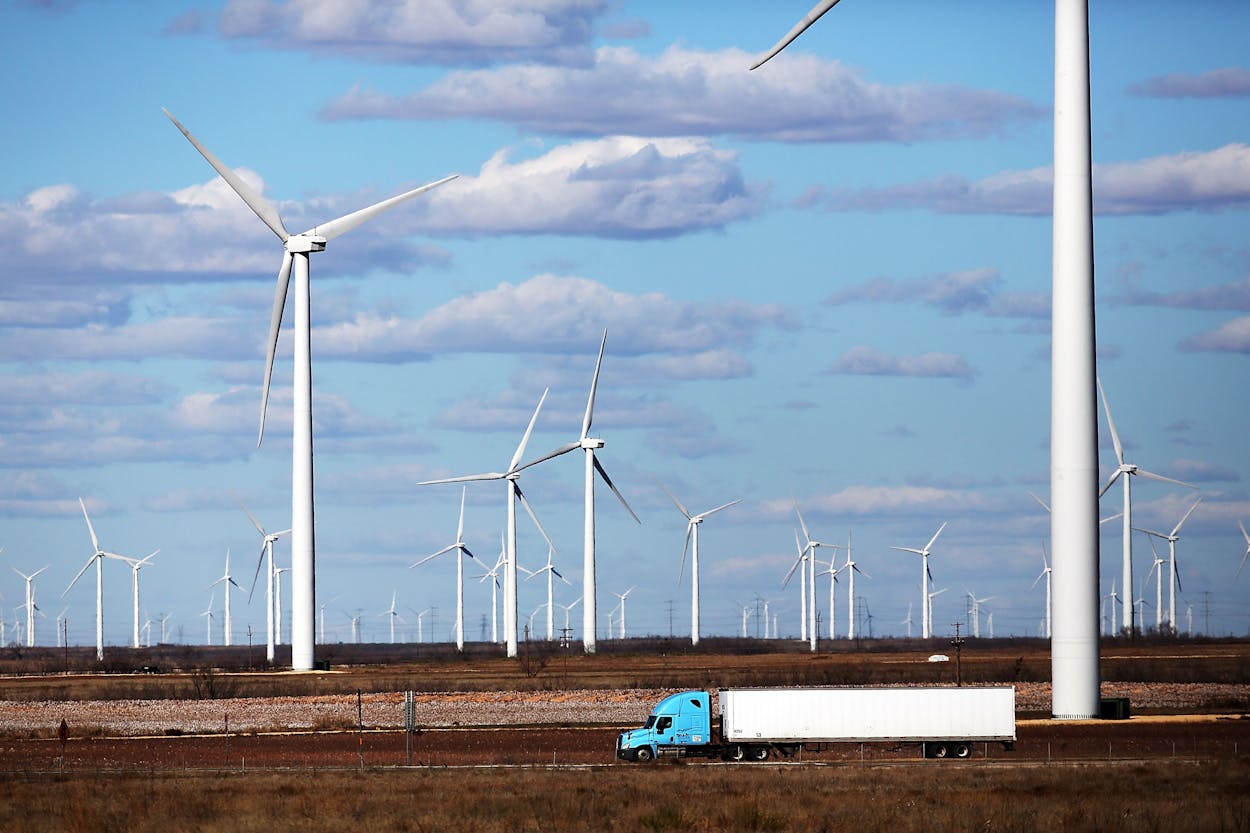Texas is America’s oil and gas capital, but it’s clean energy that’s been increasingly powering the state over the past decade. A cleaner electric grid is great news for Texans’ health and economy, if President Trump and state leaders don’t threaten progress.
Stirrings of transformation began in 1999 when the Texas Legislature deregulated the state’s electricity market, saying goodbye to monopoly providers and hello to a competitive marketplace. Competition opened the door to new players and meant power companies had to work to offer not only low-cost products, but also attributes that customers want, like clean electricity.
Shortly after the market was up and running, technological breakthroughs in hydraulic fracturing—commonly known as fracking—led to natural gas dethroning coal as the country’s cheapest power resource. Natural gas prices plummeted. In fact, 2016 natural gas spot prices were at an all-time low, roughly one-quarter of peak prices just ten years earlier.
Meanwhile, Texas was beginning to flex its wind power muscles. This was largely thanks to a forward-looking policy requiring a small portion of the state’s power come from renewables, effectively jump-starting the nation’s wind industry. The next key Texas policy authorized identifying areas with high potential for renewable energy—like windy West Texas—and then building transmission lines to carry that power to people. In 2002, the year deregulation began, wind made up less than 1 percent of Texas’s electricity mix. Last year, it was nearly 13 percent.
And Texas solar power is now poised for liftoff. As costs come down, more and more homes and businesses are taking advantage of the sun by installing panels. Texas also is on track to become the fastest-growing utility-scale solar market in the country.
This perfect storm of market, infrastructural, and technological forces is putting the Lone Star State on the path to a cleaner, more affordable energy future.
Texas has everything to gain from the clean energy economy, starting with lives saved. Carbon pollution—which coal plants spew into the air—leads to asthma attacks, heart attacks, and premature deaths. One study estimated that lowering carbon pollution from coal-fired power plants could save 2,300 Texas lives and $20 billion in associated healthcare costs by 2030.
The transition to a cleaner electric grid also is bringing with it jobs. Lots of them. Texas is home to nearly a quarter of the country’s wind power jobs, and the state’s solar jobs grew by an impressive 34 percent in 2016. Some people may be surprised to learn that wind and solar power now employs more than four times as many Texans as the fossil-fuel electricity industry. And energy efficiency—our cheapest power resource—supports nearly 150,000 Texas jobs.
Then there’s water. Coal power guzzles water like a hung over frat boy. By harnessing the power of low-water resources like wind, solar, and energy efficiency, we could reduce this waste of precious Texas water, which could be going to our cities, agriculture, and industry.
For all of these reasons and more, Texas has a lot to gain from our nationwide limits on carbon pollution from power plants, known as the Clean Power Plan. For the first time ever, the federal plan sets a pollution limit for each state’s power sector, providing states ample flexibility and time to meet that target.
Plus, cleaning our air through low-carbon energy is what Texans from both sides of the aisle want—85 percent of Texas voters support increasing the use of clean power. And 71 percent of Texans support regulating carbon dioxide as a pollutant, as the Clean Power Plan would do.
President Trump, meanwhile, recently announced attempts to take a hatchet to essential public health protections like the Clean Power Plan. The move was not surprising considering he repeatedly pledged to gut environmental protections, falsely promising to coal miners that doing so would bring coal jobs back.
Many independent analyses found that states with abundant natural gas and wind and solar resources could reap the rewards of the Clean Power Plan. In other words, it is the perfect description of Texas. The Center for Strategic and International Studies estimated that, as states across the U.S. strive to meet the Clean Power Plan’s goals, Texas and two neighboring states’ net natural gas revenues would increase almost $20 billion annually.
Trump’s rollback would actually harm job growth. America’s solar workforce grew by 25 percent last year, while wind jobs increased by 32 percent. In fact, more than 3 million Americans now work in clean energy industries like solar, wind, and energy efficiency. Coal, on the other hand, supports around 160,000 jobs—meaning clean energy employs almost 19 times more Americans.
Additionally, the state currently spends about $2 billion importing coal from outside of Texas. Rather than buying out-of-state coal, Texas should help redirect that money to creating local jobs and investment here at home by tapping more Lone Star wind and solar power.
Doing so also would have a profound impact on pollution and health. According to the U.S. Environmental Protection Agency’s own scientific analysis, the Clean Power Plan could avoid up to 3,600 deaths each year. Dismantling it means sicker Texans—kids who can’t play outside or go to school, and adults who have to miss work. And though our state’s air quality generally has been improving over the past decade, Texas still holds the dubious claim of being home to three of the most polluted cities in the country, according to the American Lung Association.
America is still a nation of laws, and Trump cannot capriciously repeal the Clean Power Plan by fiat. The rules are supposed to be based on facts, and gutting this critical health protection would require the administration to ignore facts about economics and science. I can assure Texans that Environmental Defense Fund and other groups will take President Trump to court when the administration threatens vital climate and public health protections—fighting to keep protections that are essential to the future of Texans’ wellbeing and economic prosperity.
Jim Marston is vice president for Clean Energy, Environmental Defense Fund
- More About:
- Energy






